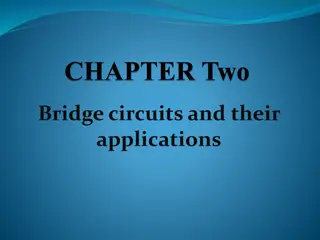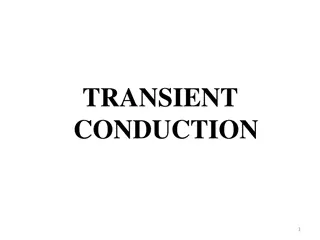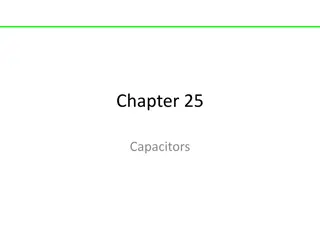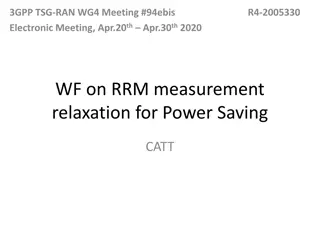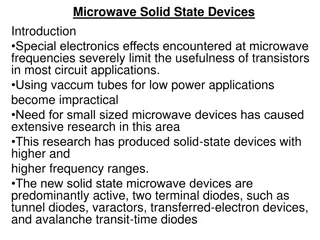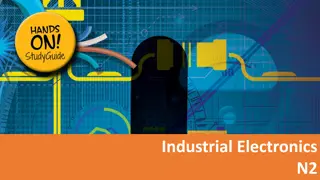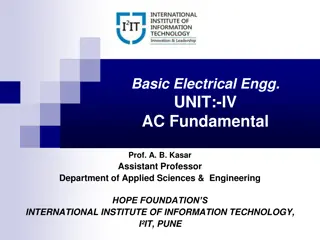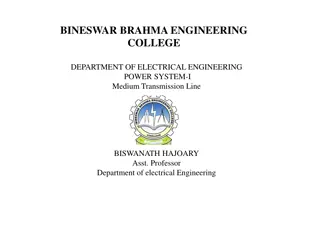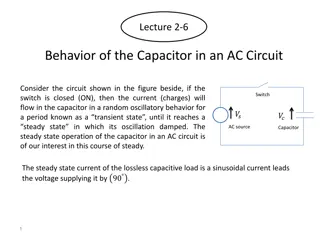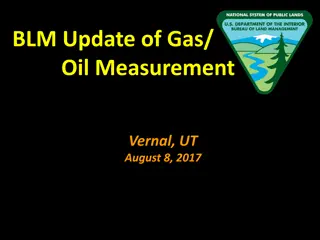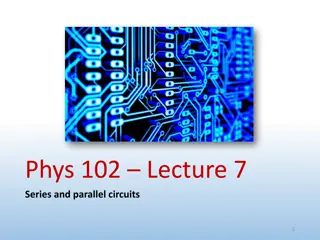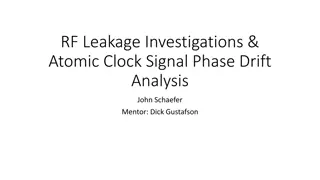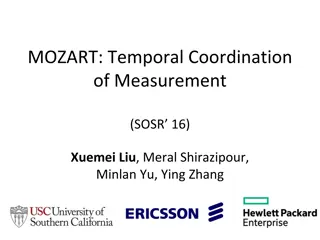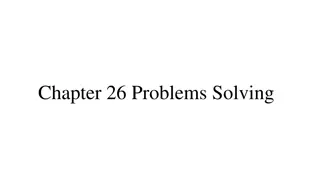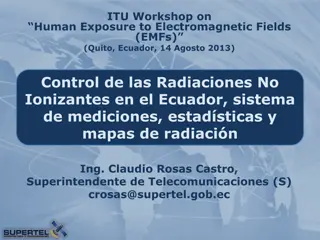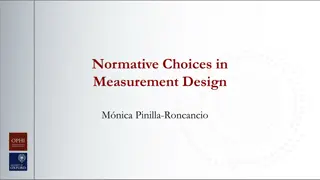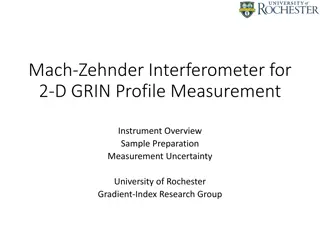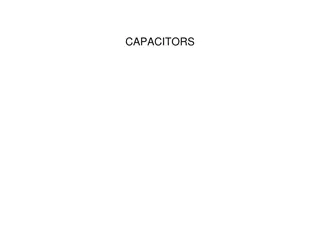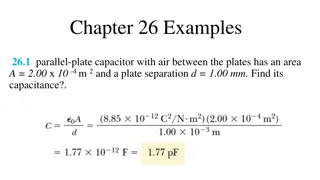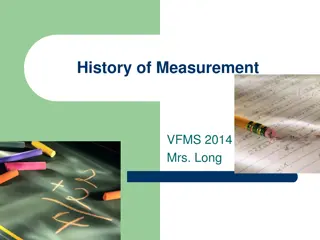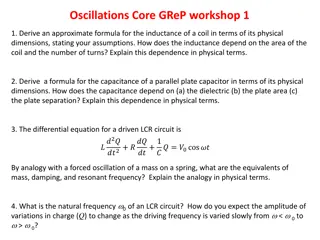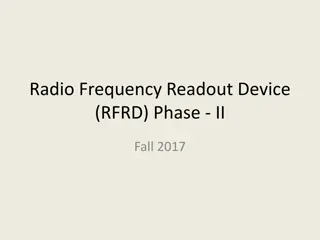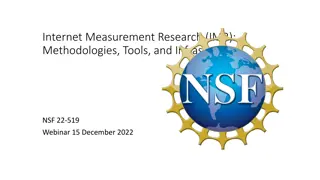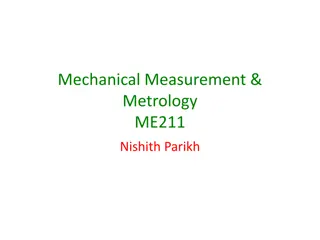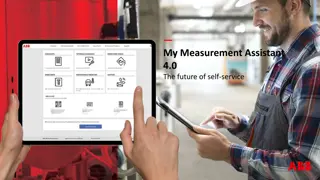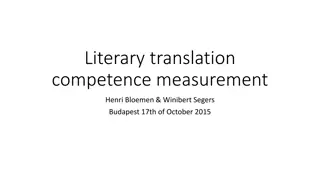Bridge circuits and their applications
Bridge circuits are commonly used for precision measurement of component values such as resistance, inductance, and capacitance. The Wheatstone bridge, a type of bridge circuit, is particularly useful for measuring small changes in resistance, making it ideal for sensor applications. By comparing un
1 views • 16 slides
Understanding Measurement Scales and Scaling Techniques
Measurement scales play a crucial role in marketing research, with techniques like scaling helping to categorize data. The content discusses four types of measurement scales: nominal, ordinal, interval, and ratio, outlining their characteristics and differences. Scaling techniques involve placing re
5 views • 7 slides
Understanding Transient Conduction in Heat Transfer
Transient conduction in heat transfer occurs when boundary temperatures change, causing temperature variations within a system until a steady state is achieved. This phenomenon is commonly seen in processes like quenching hot metals. The Lumped Capacitance Method is used to analyze such scenarios, i
0 views • 55 slides
Understanding Capacitors in Physics
Capacitors are electronic components that can store electric charge and energy. This content covers various concepts related to capacitors, such as capacitance, charge storage capacity, electric fields between plates, and capacitance calculations for different geometries. Problems and examples are p
1 views • 46 slides
Amplifier Coupling Techniques and Applications
Amplifiers utilize various coupling techniques such as resistance-capacitance (RC), inductance (LC), transformer, and direct coupling to connect different stages. Each coupling method has its advantages and applications, such as impedance matching, power transfer, and amplification of radio frequenc
2 views • 16 slides
Understanding Performance of Transmission Lines in Electrical Engineering
The performance of a transmission line in power systems is critical for efficient operation. Factors such as voltage drop, line losses, and transmission efficiency are key considerations in design and operation. The line parameters of resistance, inductance, capacitance, and shunt conductance play c
2 views • 26 slides
RRM Measurement Relaxation for UE Power Saving in 3GPP Meeting #94ebis
This document discusses methods for relaxing RRM measurements to save power in UE devices during idle/inactive states. It covers scenarios with low mobility, non-cell edge, and combinations, suggesting options like longer measurement intervals and relaxing neighbor cell measurement requirements. The
0 views • 7 slides
Understanding Varactor Diodes in Microwave Solid-State Devices
Varactor diodes, also known as varicap diodes, play a crucial role in microwave solid-state devices by offering a much higher range of capacitance change compared to ordinary diodes. These diodes operate under reverse bias conditions, utilizing the variable capacitance effect to manipulate the junct
1 views • 48 slides
Understanding Motion and Measurement of Distances in Science at Sainik School Gopalganj
Explore the concepts of motion and measurement of distances in science as taught by Dr. A.K. Choubey at Sainik School Gopalganj. Discover the development of means of transport, different measurement methods like non-standard and standard measures, the significance of measurement, and the Internation
1 views • 16 slides
Understanding Electrical Principles in Industrial Electronics
Explore the fundamentals of industrial electronics, starting with direct current principles related to atomic theory, conductors, insulators, and resistors in series and parallel. Then, delve into alternating current principles, including generating an alternating voltage, alternating current (AC) b
0 views • 46 slides
Understanding AC Fundamentals in Basic Electrical Engineering
Exploring key concepts in AC fundamentals, including definitions of alternating quantities, important terms like amplitude, time period, instantaneous value, frequency, and angular frequency. The presentation covers AC circuits with resistance, inductance, and capacitance, providing insights into RM
1 views • 25 slides
Understanding Medium Transmission Line Capacitance Methods
Medium transmission lines, with lengths typically between 50-150 km and operating at voltages greater than 20 kV, require consideration of capacitance effects for accurate calculations. This article discusses key capacitance methods like the End Condenser Method and Nominal T Method, highlighting th
3 views • 22 slides
Functional Measurement Systems Analysis for Curve Data Using Random Effects Models
Measurement Systems Analysis (MSA) is crucial in determining the contribution of measurement variation to overall process variation. When dealing with curve data instead of single points, a Functional MSA approach using random effects models can be applied. This involves estimating mean curves, mode
0 views • 5 slides
Understanding Electronic Distance Measurement in Surveying
Electronic Distance Measurement (EDM) is a precise method for measuring distances between two points using electromagnetic waves. It offers speed and accuracy, especially useful for long or inaccessible distances. EDM, a type of surveying instrument, measures phase changes in energy waves traveling
0 views • 7 slides
Understanding Measurement and Instruments in Research
Exploring the significance of instruments in research, this content delves into the development and utilization of measures for concepts like caring. It covers the various devices used to measure constructs, the rules governing measurement assignment, direct versus indirect measurement methods, and
2 views • 64 slides
Emittance Measurement Techniques and Analysis
Various emittance measurement techniques like Solenoid and Viewscreen, Single Slit and Viewscreen are discussed in this document along with details on the measurement process, equipment setup, and data analysis methods. Emittance calculations, beamlet intensity profiles, and space-charge dominated b
0 views • 11 slides
Exploring Measurement Challenges and Concepts in Grade Five Mathematics
Delve into a variety of measurement challenges in Grade Five mathematics, including different units, common errors, measurement components, big ideas, accuracy, precision, and the measurement process. Understand the nuances between accuracy and precision, factors affecting measurement accuracy, and
0 views • 39 slides
Understanding Capacitor Behavior in AC Circuits
Capacitors exhibit unique behaviors in AC circuits, transitioning from transient to steady states. By analyzing the interaction between source voltage and capacitance, we can derive key relationships such as phase differences and power transfers. Understanding these principles is essential for desig
0 views • 16 slides
Update on Gas and Oil Measurement Rules in Vernal, UT
New rules for gas and oil measurement were implemented in Vernal, UT on August 8, 2017. These rules focus on site security, facility measurement points, recordkeeping, and incorporating industry standards. The regulations aim to approve new measurement technology, update standards, and address gaps
1 views • 87 slides
Electric Circuits: Series and Parallel Configurations Explained
In this lecture on electric circuits, we delve into series and parallel circuits featuring batteries, wires, resistors, and capacitors. Key concepts discussed include Kirchhoff's loop rule, series components, and equivalent resistance and capacitance. Learn how to simplify complex circuits and analy
0 views • 24 slides
RF Leakage Investigations & Atomic Clock Signal Phase Drift Analysis
RF signals ranging from 100 kHz to 150 MHz are utilized for achieving resonance in optical cavities. DC Ground Isolation Units help decouple DC grounds and shield leakage. Spectrum analysis using RF analyzers reveals peaks possibly from neighboring balun leakages. Solutions involve increasing capaci
0 views • 14 slides
Re-evaluating Measurement Algorithms in Software Domain
This content explores the importance of measurement algorithms in software, focusing on network function virtualization (NFVs) and software switches. It discusses the critical role of measurement in decision-making for firewall, load balancing, and intrusion detection systems in managing NFVs. The n
0 views • 22 slides
Temporal Coordination of Measurement in Data Centers
Measurement plays a crucial role in data centers for fault diagnosis, traffic engineering, and attack detection. This study focuses on the concept of temporal coordination of measurement to overcome issues like reporting overhead and resource wastage. Various examples illustrate the importance of co
0 views • 29 slides
Capacitor Problems and Solutions
Explore a series of capacitor-related problems, including calculating charge, radius, capacitance, electric field, and more. Dive into scenarios involving capacitors connected to batteries, liquid drops with capacitance, Earth and cloud layers as capacitor plates, air-filled capacitors, surface char
0 views • 18 slides
Regulation and Measurement Process of Non-Ionizing Radiation Exposure in Ecuador
This content discusses the regulation and measurement methods for non-ionizing radiation exposure in Ecuador, including maximum exposure limits, measurement procedures, and information dissemination to the public. It covers topics such as international recommendations, measurement techniques, data p
0 views • 30 slides
Choices in Measurement Design and National Poverty Assessment
This content discusses normative choices in measurement design, normative reasoning, relevance, usability, essential choices for creating an Alternative Poverty Measure (AF Measure), alongside measurement design considerations, and a purpose statement for a National MPI. It emphasizes the importance
0 views • 33 slides
Mach-Zehnder Interferometer for 2-D GRIN Profile Measurement
Mach-Zehnder Interferometer is a powerful tool used by the University of Rochester Gradient-Index Research Group for measuring 2-D Gradient-Index (GRIN) profiles. This instrument covers a wavelength range of 0.355 to 12 µm with high measurement accuracy. The sample preparation involves thin, parall
0 views • 6 slides
Understanding Television Research: Markets, Measurement, and Methodologies
Explore the world of television research through topics such as television markets, measurement approaches, local measurement services like Nielsen and Comscore, and Nielsen's measurement methodologies. Learn about Designated Market Areas (DMAs), Household Demographics, People Meters, Portable Peopl
0 views • 42 slides
UE PRS Measurement Requirements Discussion at 3GPP TSG-RAN WG4 Meeting #98-e
Discussion at the 3GPP TSG-RAN WG4 Meeting #98-e focused on UE PRS measurement requirements. The topics included consideration of muting in measurement periods, periodicity scaling for PRS resources, handling different resource periodicities, and offsets in measurement periods. Various options were
0 views • 18 slides
Understanding Capacitors in Electric Circuits
Exploring various scenarios involving capacitors in electric circuits, from analyzing the electric field between capacitor plates to determining stored energy and capacitance differences. Topics covered include equilibrium charge distribution, potential energy comparison, and stability of interconne
0 views • 7 slides
Capacitors: Examples and Applications
Explore examples of parallel-plate capacitors with varying dimensions and configurations, calculating capacitance, maximum charge, and energy storage. Understand how capacitors behave in circuits and how to determine equivalent capacitance in complex setups.
0 views • 9 slides
Evolution of Measurement Systems Over Time
Explore the fascinating journey of measurement systems from historical units like cubit and fathom to the modern metric system. Discover how civilizations developed standardized units for length, weight, and mass. Follow the timeline of measurement advancements, from King Edward's iron ulna to the b
0 views • 36 slides
Understanding Inductance and Capacitance in Electric Circuits
Explore the derivation of inductance and capacitance formulas in terms of physical dimensions and learn about the dependencies on coil area, number of turns, dielectric, plate area, and plate separation. Understand how inductance relates to magnetic flux and coils while capacitance is linked to char
0 views • 16 slides
Understanding Accounting Research Methods: Measurement and Sampling
Measurement is a crucial aspect of research in accounting. It involves assigning numbers to empirical events, objects, or properties. Measurement consists of selecting measurable phenomena, developing mapping rules, and applying these rules appropriately. The process of measurement includes determin
0 views • 63 slides
Radio Frequency Readout Device (RFRD) for Tightness Measurement of Anchor Bolts
The Radio Frequency Readout Device (RFRD) Phase II project aims to reduce the time needed to check the tightness of nuts on anchor bolts. By utilizing a passive RFRD that measures capacitance changes in washers, the system offers a wireless, cost-effective solution for monitoring nut tightness. With
0 views • 27 slides
Comprehensive Guide to Pressure Measurement Methods
This comprehensive guide delves into the definition, units, and terminology of pressure measurement, covering low and high-pressure measurement techniques such as McLeod Gauge, Thermal Conductivity Gauge, Ionization Gauge, Manometers, and Electrical Resistance Pressure Gauge. It also explores the re
0 views • 56 slides
Advancing Internet Measurement Research: IMR Program Overview
The Internet Measurement Research (IMR) program aims to enhance Internet measurement methodologies, tools, and infrastructure for a comprehensive understanding of wired and wireless networks. It promotes the development of new data collection methods, measurement tools, and related infrastructure. T
0 views • 23 slides
Mechanical Measurement & Metrology ME211 Teaching Scheme and Syllabus
Teaching scheme includes lectures and labs schedule, continuous examination plan, evaluation criteria, internal assessment, and syllabus covering measurement concepts, linear and angular measurement, gear terminology, measurement of mechanical parameters, and miscellaneous metrology topics. Recommen
0 views • 18 slides
My Measurement Assistant 4.0 - The Future of Self-Service
My Measurement Assistant 4.0 is a cutting-edge self-service application designed to enhance customer experience and support for ABB measurement devices. It offers a wide range of features such as spare parts identification, error code identification, temperature performance estimation, and remote su
1 views • 34 slides
Understanding Competence Measurement in Literary Translation
Exploring the concept of competence measurement in literary translation, this text delves into the ELV competence model, a five-step scheme for measurement, reliability versus validity, and the relationship between competence measurement and translation product evaluation. It discusses the importanc
0 views • 18 slides
